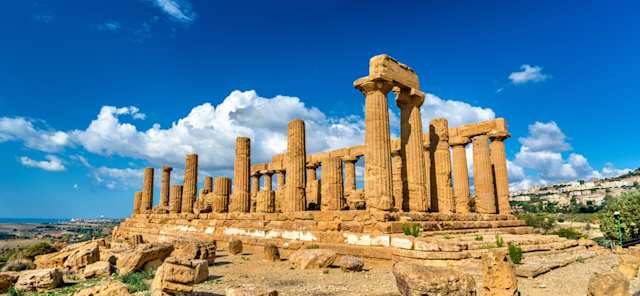The Ultimate Sicily Travel Guide
All you need to know about travelling to Italy’s largest island
~

Just three kilometres separate Sicily from mainland Italy, but it couldn’t be more different—even the locals see themselves as Sicilians first and Italians second. It’s truly a place of extremes, where you can find a remarkable selection of archaeological sites, dreamy beaches, paradisiacal islands, raging volcanoes and quaint towns and villages, all within a few hours' drive. Our travel experts here at Plum Guide have been and done it all, and we’ve put together an expert Sicily travel guide to help you have the trip of a lifetime. Check out our pick of the top things to do, the best areas to visit, where to stay and what to eat.
General info about Sicily
With a history dating back 10,000 years, its strategic location at the centre of the Mediterranean has given Sicily an unparalleled historical legacy. Fewer places have seen a history influenced by the Phoenicians, Greeks, Romans, Byzantines, Arabs, Normans, French, Germans, Spanish, Italians and British. Naturally, such a rich history means plenty of fascinating gems on the island, and you could spend your entire trip stepping back in time and discovering its eclectic past.
Best time to visit Sicily

View of San Vito Lo Capo beach with Monte Monaco in the background, Sicily
Luckily, the Sicilian weather remains favourable throughout the year. Spring is a lovely time to visit, with mild weather and Easter festivities in full swing. Autumn and winter are mild by European standards and are still great times to visit. There are even skiing opportunities around Mount Etna and Monti Madonie. The only time we would recommend avoiding is the peak summer months. This is when the sun is at its hottest, and dusty winds blow in from North Africa, not to mention competing for space on the beaches and attractions.
How to get to Sicily
There are two main airports in Sicily, Palermo in the west and Catania in the east, and both are well-connected with cities in mainland Italy. There are also two smaller airports at Comiso and Trapani and domestic airports on the islands of Pantelleria and Lampedusa. There are also ferry connections to Sicily from Naples, Salerno, Civitavecchia, Genoa, Cagliari, Malta and Tunisia.
Top activities and attractions
Volcanic exploring

The Stromboli island and volcano in Sicily, Italy
With three active volcanoes—Etna, Stromboli and Vulcano—Sicily is the perfect location for volcanic exploration. Take the narrow-gauge railway or cable car (or if you’re up for a challenge, try the hike) up to the top of Etna for magnificent views. You can also catch regular eruptions on Stromboli and other volcanic phenomena, such as the steaming mud baths of Vulcano and the underwater gases of Panarea island.
Beaches
Engulfed by the Mediterranean, Ionian and Tyrrhenian Seas, Sicily is the ultimate beach destination. There are endless sandy beaches where warm, clear waters lap gently against the shores. The undeveloped Torre Salsa lies within a WWF nature reserve and is a great spot to snorkel and scuba dive. In the northwestern part of the island, the idyllic San Vito Lo Capo is sheltered by a towering headland and backed by swaying palm trees.
Island hopping

The Levanzo island, Aegadian Islands, Italy
Embark on an island-hopping adventure for picture-postcard views. The magical Aegadian Islands, just a short ride from Trapani, are an excellent spot for relaxing, hiking and discovering the archipelago’s magical underwater world. To the south of Sicily lie the Pelagie Islands, where you won’t be able to resist spending long, lazy days on the secluded beaches. Finally, heading north of Sicily, you’ll find the UNESCO-protected Aeolian Islands, which offer everything from trekking hissing volcanoes to sipping Malvasia wine.
Ancient sites

The Temple of Juno in the Valley of the Temples, Agrigento, Sicily
Sicily is packed with so many historical sites that it may as well be an open-air museum. One of the most famous spots is the sprawling Valley of Temples, the largest archaeological site in the world. Located just outside Agrigento, these eight temples date back as far as 500 BC and are some of the world's most perfectly preserved Greek ruins. Other fascinating sites include the temples of Segesta and Selinunte and the Greek temples of Syracuse, Palazzolo Acreide, Tyndareus and Taormina.
Natural wonders
Sicily is a beautiful place to return to nature, with many dramatic landscapes waiting to be explored. Orientata dello Zingaro nature reserve consists of a mountain chain and a long coastline, where you can hike through the park and along the coast. There are plenty of pristine little bays where you can take a cooling dip after your hike. The Alcantara Gorge is another natural wonder created centuries ago by flowing magma. Take a stroll along one of the trails to see the waterfalls, or kayak your way down the rapids.
Hidden gems

The town of Piazza Armerina in Enna, Sicily
As well as the top activities and attractions above, Sicily is full of hidden gems away from the tourist trail. For example, the hidden beaches of the Vendicari nature reserve are a string of beautiful coves with no other sign of life except for the herons, egrets and pink flamingos, which appear in spring and autumn. Another must-visit, especially on a hot day, is the turquoise swimming pools of Cava Grande. Filled up by the clear mountain stream, which tumbles into the pools, this is a fantastic place to escape the crowds. Speaking of running the crowds, Enna is one of Sicily’s best-kept secrets, rarely visited by tourists, one we couldn’t miss out on our Sicily travel guide. Perched on a hilltop surrounded by rolling green hills, the town offers a wonderful taste of local life.
Best areas to visit and stay in
Cefalu

The coastal city of Cefalù
This charming seaside town on Sicily’s north coast is the best place to live out la dolce vita. Spend long, lazy days lounging on golden sands, dipping into clear blue waters to cool down. Take a leisurely stroll through town, admiring its honey-hued stone buildings and narrow cobbled streets, stopping to visit the magnificent Arab-Norman cathedral. If you’ve consumed too many gelatos, hike up La Rocca for incredible coastline views. End the day at the old harbour, the sun dipping below the rows of fishing boats.
Etna

Greek amphitheater ruins in Taormina with a view towards Mount Etna
Whether you opt for the cable car or take the challenging climb instead, visiting Mount Etna is undeniably one of the best activities on any Sicily travel guide. It’s one of the most active volcanoes in the world, and it’s not uncommon to see its cone spewing plumes of smoke. The surrounding area is a great place to spend time, where you can enjoy amazing views of the volcano. If you visit during the winter, you can even have fun skiing and sledging down the slopes.
Catania

The main city square Piazza del Duomo in Catania
The ancient port city of Catania lies on Sicily’s east coast at the base of Mount Etna. The city centre is relatively compact, so it’s easy to get around on foot and explore some of its best sights like the Piazza Duomo and cathedral, Ursino Castle and Monastero dei Benedettini. Get lost in the hullaballoo of the famous fish market La Pescheria, sampling the catch of the day at the nearby seafood restaurants.
Palermo

The Monreale Cathedral in the Metropolitan City of Palermo
With endless things to see and do, you could easily spend your entire trip in Sicily’s picturesque capital. Palermo is ideal for those who like to wander; it's a maze of streets lined with ornate buildings and hidden squares to relax in. There are plenty of museums, galleries, theatres and religious buildings to see, and the city’s markets—Capo, Ballarò and Borgo Vecchio—are packed with delicious local specialities.
Taormina

Ancient Greek theatre in Taormina, Sicily
One of the most popular summer destinations for Italians, this picturesque resort town on Sicily’s east coast is straight out of a postcard. Perched on the side of a mountain overlooking Sicily’s bright blue coastline, Taormina is famous for its ancient Greek theatre dating back to the third century. Today, the theatre still hosts dramas, concerts, symphonies, operas and ballet performances, and music festivals in the summer. A cable car ride takes you down to the glittering beaches below, caves and hidden coves aplenty.
Val di Noto

View from above of the city in Ragusa, Val di Noto, Sicily, Italy
Located in southeastern Sicily, the Val di Noto area comprises a series of eight towns—Caltagirone, Catania, Militello, Modica, Noto, Palazzolo, Ragusa and Scicli. These baroque-style towns offer endless historical and architectural gems, from Noto’s Cathedral of San Nicolò to Caltagirone’s delightful enamelled ceramics. Many of the towns are also home to ancient Greek theatres, temples, and prehistoric settlements.
Eating out in Sicily
Local delicacies

Sicilian cannoli pastries made with ricotta cheese and orange
With influences from Arabia, Africa, Spain and Italy, Sicilian cuisine is a melting pot of flavour. So we wouldn’t blame you if you only came to Sicily to eat. Discover delicacies like soft and crispy arancini (deep-fried ball of creamy risotto), pasta alla norma (pasta with local tomatoes, aubergines, garlic, basil and fresh ricotta), cassata siciliana (sponge cake soaked with fruit juices or liqueur and layered with ricotta and candied fruit) and the classic cannoli (tubes of fried dough filled with creamy ricotta).
Where to find food
To find snacks and small bites, the best places to go are the many markets (Ballarò in Palermo, La Pescheria in Catania), sandwich bars or grocery stores. In larger cities, you’ll occasionally find an old-fashioned focacceria which sells bread-based snacks and the ubiquitous rosticceria, a takeaway grill house. If you’re after something a little more filling, head to a trattoria for simple home cooking or a ristorante for a more upscale meal.















